Schneider
Trophy Races
Jacques Schneider was
an accomplished hydroplane racer.
After being introduced to flying by Louis Bleriot and Wilber
Wright he began to think about combining hydroplane and
aircraft racing. In December 1912 while in
Chicago for the
Gordon Bennett Aviation Cup races he offered to support an
annual contest for seaplanes with a trophy and prize money
for the first three years.
Schneider was looking for designers
to produce practical airplanes that could
operate from
large bodies of water for transportation. The
aero club of
any country winning the trophy
three times in five years
would become the permanent trophy holder and the
contest
would end.
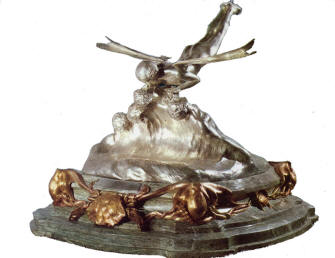
Schneider Trophy
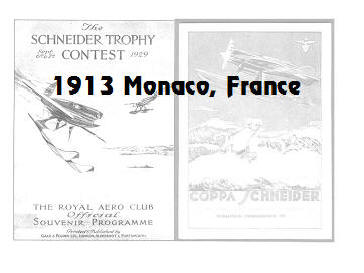
April 16, 1913 - 28 laps of a 10-km. course
France, the leader in aviation technology posted
three strong contenders
for the first Schneider race. The USA sent only
one. France's Maurice
Provost was off first, followed by Roland Garros who swamped his engine
on takeoff and had to be towed back to the start. Charles Weymann
and
Gabriel Espanet were off and gaining on
Provost. The Nieuport's had a
speed advantage over the Deperdussin but Provost's flying skill in the four
turns kept him in the
lead. As the race went on Garros and Weymann
withdrew. On lap 25 Espanet's engine suffered a oil line break forcing him
to land. Now
Provost landed on the water and taxied over the finish
line.
The rules of the race
called for flying over the finish line to complete
the
race but
Provost refused. Garros than started his now dried out engine
and took off. This
caused Provost to reconsider, he took off and flew over
the finish line to win. 1913 was the only year a French entry finished
the race
| No. | Pilot |
Aircraft |
Country |
Speed |
|
19 |
Maurice Provost |
Deperdussin |
France |
45.75 |
|
6 |
Gabriel Espanet |
Nieuport |
France |
62.5 * |
|
5 |
Charles Weymann |
Nieuport |
USA |
** |
|
1 |
Roland Garros |
Morane-Saulnier |
France |
*** |
* Out on lap 25
** Out on lap 8
*** did not start
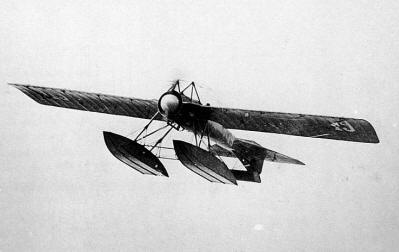
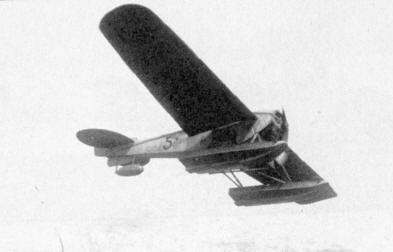
Deperdussin
Nieuport
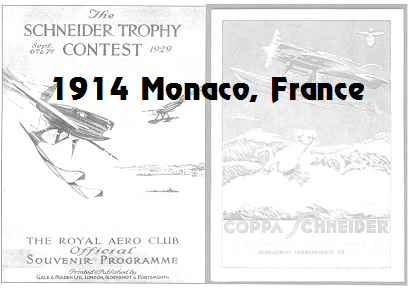
April 20, 1914 - 28 laps of a 10 km. course
The two French entries, Gabriel Espanet & Pierre
Levasseur were the first off.
Switzerland's Ernest Burri's flying boat experienced difficulty
getting off the water.
Howard Paxton was off last and it soon became apparent the
British Sopwith
Tabloid had superior speed, building a great lead
even though one of the nine
cylinders of the Gnome rotary engine was misfiring, but the other eight
preformed
extremely well. Levasseur and Espanet both experienced engine
failures when
the second row of their twin row engines overheated and seized. The Swiss F.B.A
seaplane had to land and refuel but managed to get
off the waterand finish the race.
Howard Pixton's 1914 Schneider win gave Britain its first big
international victory.
|
No. |
Pilot |
Aircraft |
Country |
Speed |
|
3 |
Howard Pixton |
Sopwith Schneider |
England |
86.464 |
|
7 |
Ernest Burri |
F.B.A. |
Switzerland |
51.375 |
|
6 |
Pierre Levasseur |
Nieuport |
France |
* |
|
5 |
Gabriel Espanet |
Nieuport |
France |
** |
|
4 |
Lord Carberry |
Deperdussin |
Great Britain |
*** |
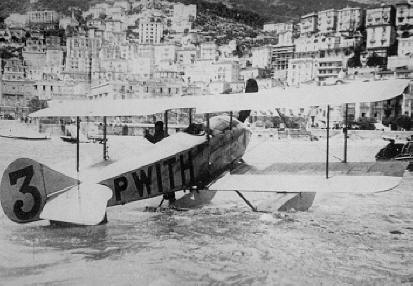
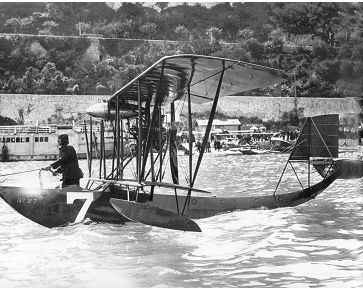
Swiss F.B.A. Sopwith Schneider
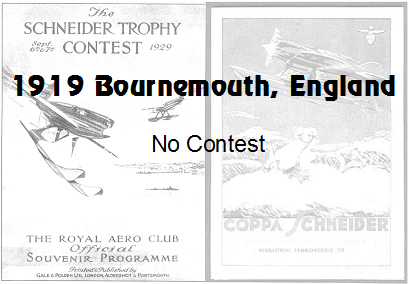
September 10th 1919 - 10 laps of a 37-km. course
The Schneider
Races resumed in 1919 in England after a six year no-race
period due to the World War. Not enough thought went into
planning the
race course which caused many problems. Failure to
secure an area of the
beach for aircraft and crews allowed boaters and spectators to be a
problem.
Race numbers and starting positions were not assigned
till the last minute.
Due to very poor visibility (fog) the start of the race was put
back from 2:30
to 6:00 pm. The system of signals used to keep the spectators
informed as
to who was flying at the time was too confusing to keep anyone
informed.
Vincent Nicholl was first off and did find his way in the fog to the marker
boat
narrowly missing the boat's mast and later a unidentified aircraft. Finding
his
way back to the start line Nicholl withdrew from the race. Hobbs took off
in the
Sea Lion but landed somewhere down the race course due to the fog.
He than
decided to fly back and start again and struck a floating object on take
off which
opened a large hole in the hull, the Sea Lion turned over and
sank. Hobbs was
rescued by a boater. Harry Hawker took off without an official start,
made one
lap and landed due to the fog When the 2:30 start time was put
back the Sadi
Lecointe team pulled the Spad on shore to repair a leaking
starboard float but
were unable to repair the leaking float by start time.
Sgt. Jannello of Italy got off to a good start and completed the 10
laps. However
one of the timekeepers reported his laps were too fast for the aircraft's
known
speed. One of the boat marker judges reported Jannello did not pass one of
the
markers and he was disqualified. To avoid
the possibility of an 'international
incident' the trophy was awarded to Italy.
This decision was felt unfair to the
pilots who flew in the fog. On Oct. 24th the FAI removed
the trophy from Italy
but gave Italy the honor of organizing the 1920 race. Great
Britain's organizing
failures of The Schneider Race was now dubbed "The fiasco in the fog"
|
No |
Pilot |
Aircraft |
Country |
Speed |
| 7 | Sgt. Jannello | Savoia 13 |
Italy |
|
|
1 |
Vincent Nicholl |
Fairey 111A |
Great Britain |
* |
|
5 |
Basil Hobbs |
Sea Lion |
Great Britain |
** |
|
6 |
Sadi Lecointe |
Spad |
France |
*** |
|
3 |
Harry Hawker |
Sopwith |
Great Britain |
**** |
* Withdrew after one lap due to fog
** Landed, took off and ran out of fuel
*** Withdrew due to fog
**** Withdrew after one lap due to fog
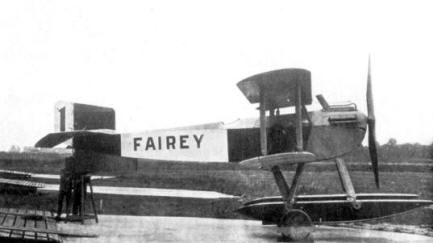
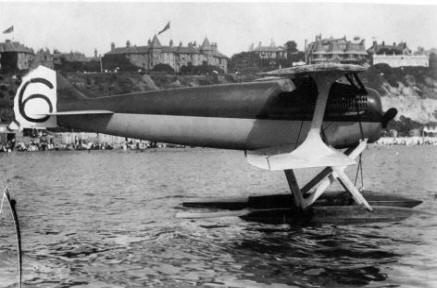
Fairey
Spad
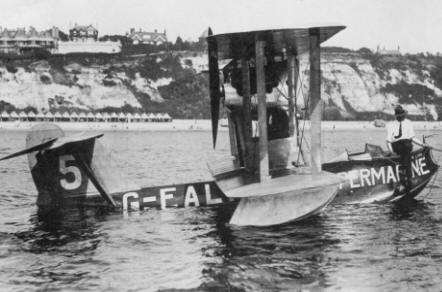
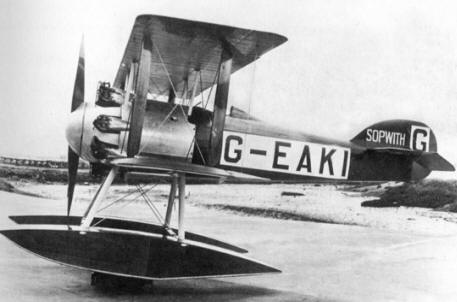
Sea Lion
Sopwith
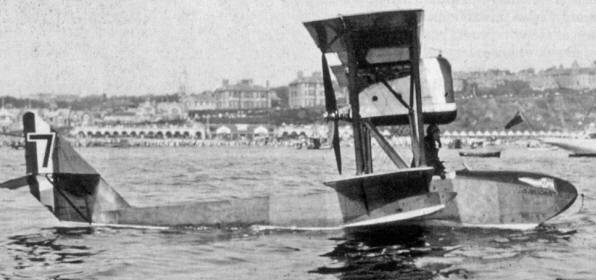
Savoia 13
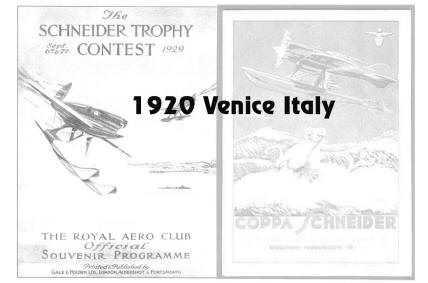
September 20-21 1920, - 10 laps of a 37.5 km.
course
As the 1920 Schneider Races
approached, both England and France were looking
at economic downturns. England was unable to attract any entries for the
race.
Switzerland was not interested. Italy the host country for 1920 was able to
secure
a rule change which required an additional 660 pounds of ballast to all
racers.
The reason for the change was the fact Jacques Schneider conceived the race to
promote the advancement of passenger carrying seaplanes and the
extra 660
pounds would represent the weight of some passengers. This extra weight of
course favored the larger Italian flying boats. France entered one aircraft and
the
Italians entered a total of four bi-plane flying boats. Italy's
Macchi M.7 piloted by
Giovanni de Briganti the only one to finish, won the race.
|
No |
Pilot | Aircraft | Country |
Speed |
|
1 |
Giovanni de Briganti |
Macchi M.7 |
Italy |
117.8 |
|
14 |
Piero Corgnoline |
Macchi Naval M,7 |
Italy |
* |
|
4 |
Artuo Zanetti |
Macchi M.19 |
Italy |
** |
|
5 |
Sadi Lecointe |
Nieuport-Delage 29 |
France |
*** |
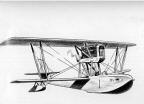
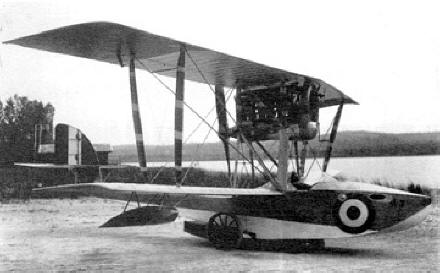
Macchi M.7
Macchi Naval M.7
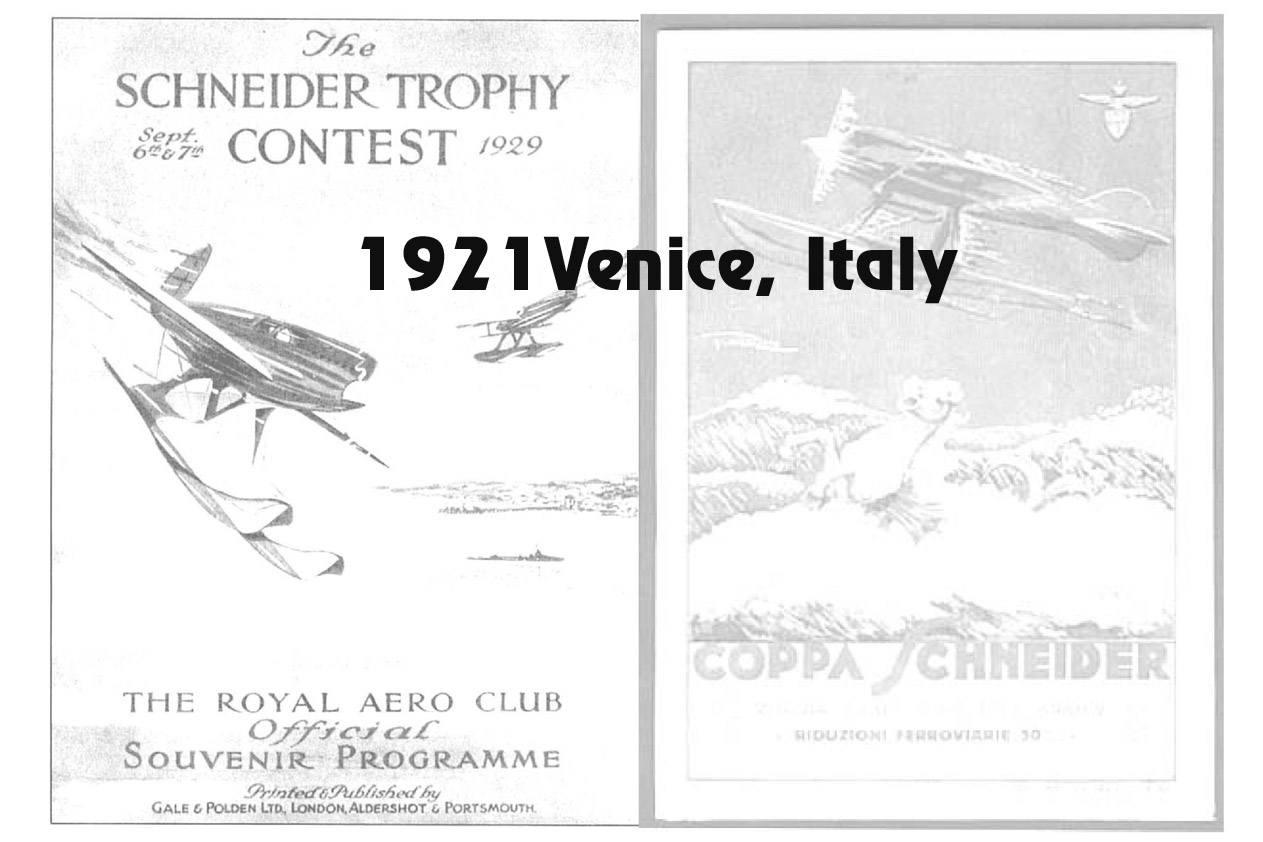
August 6-7, 1921 - Venice, Italy, - 16
laps 24.6 km.Course
Italy the host nation introduced some new rules to stop the possibility of
production
of special light weight race planes. In 1920 the additional rule was to requiring each
race plane carry 660
pounds of
ballast. This year was to additional sea worthy and
a 6 hr floatation test. A
new 5,000F registration deposit was added to discourage
unrealistic entries. French pilot Sadi Lecointe on a practice run
made a hard landing
bending the float struts
and damaging the floats. With the French out it would be a
guaranteed Italian win. The 52 ft. wingspan two
man crew Italian Macchi M.19's
engine caught fire when it's crankshaft broke, Pilot Artuo Zanetti
was able to land the
M.19 safely and both crew members survived. Italy has now won two
years in a row.
|
No |
Pilot | Aircraft | Country |
Speed |
|
1 |
Giovanni de Brigani |
Macchi M.7 |
Italy |
117.8 |
|
14 |
Piero Corgnolino |
Macchi Naval M.7 |
Italy |
* |
|
4 |
Artuo Zanetti |
Macchi M.19 |
Italy |
** |
|
5 |
Sadi Lecointe |
Nieuport-Delage |
France |
*** |
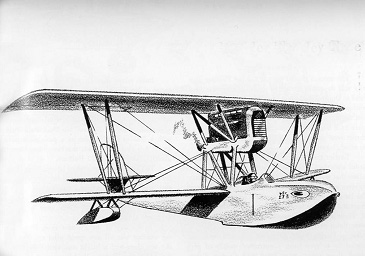
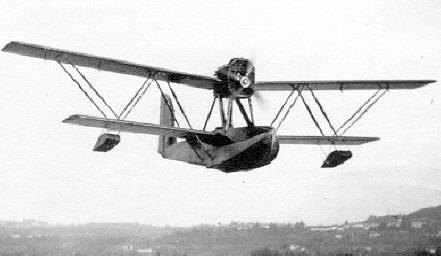
Macchi M.7
Macchi M.19
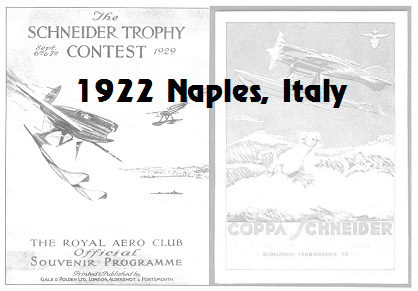
August 10-12, 1922 - 13 laps of
a 28.5-km. course
With two victories behind them and the home field
advantage, Italy was looking for the trophy.
France and Italy had government funding, however
Great Britain had to depend on a private
sponsor by the name of Hurbert Scott-Paine. Also
the D Napier Company agreed to supply a
Lion engine plus both Shell and Wakefield
promised to furnish all the necessary fuel and oil.
Reginald Mitchell added his input to the redesign of the
450 hp Napier Lion engine creating a
fast airplane. All pilots tried to access the skills of the other pilots while
trying not to show theirs.
The Italians race strategy was to bunch together at the turns
to try to keep the Sea Lion from
passing the but Biard just flew over the top of them. When
Passaleva's Savoia tried to pass, his
propeller started vibrating causing him to reduce power. Biard won
keeping the Schneider alive.
|
No |
Pilot | Aircraft | Country |
Speed |
|
14 |
Henry Biard |
Sea Lion II |
Great Britain |
145.7 |
|
8 |
Allessandro Passaleva |
Savoia S. 51 |
Italy |
142.6 |
|
9 |
Arturo Zanetti |
Macchi M. 17 |
Italy |
132.7 |
|
10 |
Piero Corgnolino |
Macchi M.7bis |
Italy |
124. |
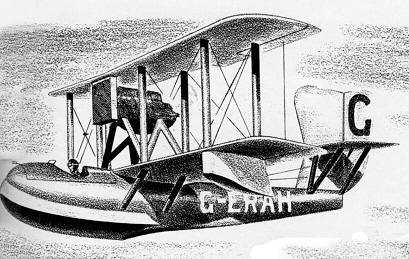
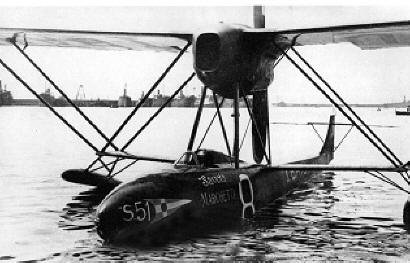
Sea Lion II
Savoia S. 51
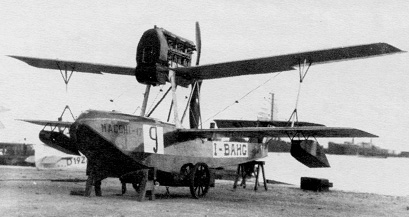
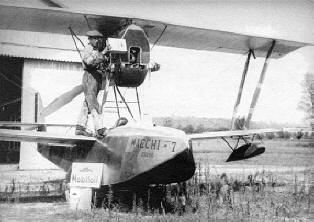
Macchi M.17
Macchi M. 7
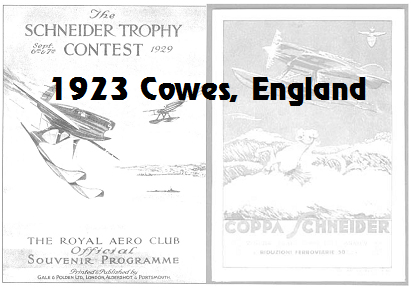
September 27-28, 1923 - (5 laps of a 68.9 km.
course)
The race at Cowes, England attracted
entries from France, Great Britain and USA. Italy
was not able to field any entries due to lack of
funding by the government at the time.
The governments of France and Great Britain were also lacking
funding for new planes.
Two of the American entries were proven race plane designs adapted
as seaplanes with
newly designed Curtiss D-12 engines. The American pilots were
trained in racing as part
of their military flight training. With no funding for new aircraft
Supermarine relied on Sea
Lion but it was out-classed by the two new US Navy
aircraft. The French C.A.M.S. 38
suffered damage in a collision and the C.A.M.S. 36bis never arrived for
the race at Cowes.
The American one-two victory saw the race change for it's
original intent to develop new
seaplanes for transportation to an all out speed aircraft speed event. The
Americans with
no competition for the 1924 races could have gained an easy
victory but declared a 'no
contest' which was most generous.
|
No |
Pilot | Aircraft | Country |
Speed |
|
4 |
David Rittenhouse |
Curtiss CR-3 |
USA |
177.2 |
|
3 |
Rutledge Irvine |
Curtiss CR-3 |
USA |
173.3 |
|
7 |
Henry Biard |
Sea Lion III |
Great Britain |
157. |
|
9 |
Maurice Hurel |
C.A.M.S. 38 |
France |
* |
|
10 |
Georges d'Oisy |
C.A.M.S. 36bis |
France |
** |
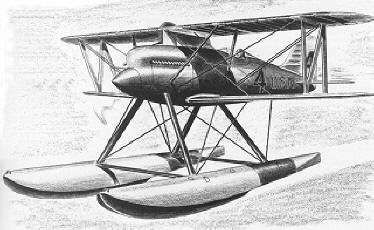
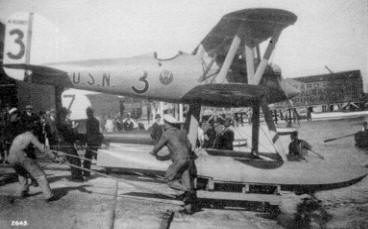
Curtiss CR-3
Curtiss CR-3
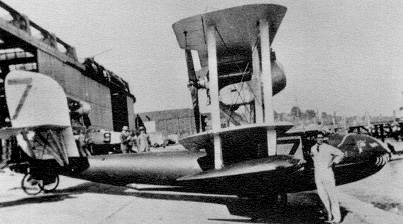
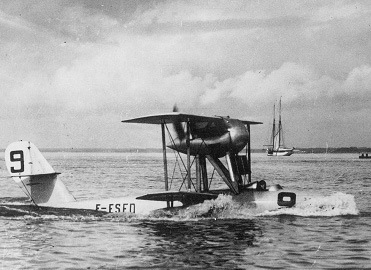
Sea Lion III
CAMS 38
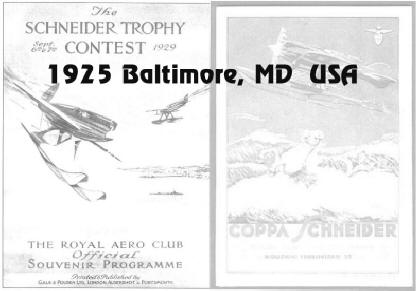
October 26, 1925 - 7 laps of a 50km. course
Preparations at Baltimore for the Schneider Races were not
good. No hangars had been
built and no crew quarters were available for the arriving British teams. The
weather was
not good with heavy rains and strong winds to add to the many problems of
setting up.
1925 would be the first year for monoplane racers and for R.J. Mitchell's first
Schneider
design. The Supermarine designed by Mitchell employed a cantilever wing (the
only one)
with flaps that could be operated also as ailerons. Supermarine
pilot Henry Biard flying
a navigability test went into a vertical bank and the racer stalled,
crashing into the water.
Able to escape the crash uninjured, Biard was convinced it was aileron
flutter that caused
the stall. This year the British team received government aid, but the
Italian team received
no financial aid. Two used Curtiss D-12 engines were loaned
to the Italian team by the US.
One of the US Curtiss fighters entered had several weeks before won the Pulitzer
Race.
US Army pilot 1st Lieutenant Jimmy Doolittle would fly the same plane now
equipped with
floats. Doolittle was off the water first with Broad next in the Gloster III.
Doolittle's ability
to take very tight pylon turns at full speed was not matched by
either by Cuddihy or Oftsie.
Britain's Gloster III not able to match Doolittle's speed came in second.
The other two US
Curtiss racers retired with engine problems. Italy's
Macchi M.33 finished in third place.
|
No |
Pilot | Aircraft | Country |
Speed |
|
3 |
Jimmy Doolittle |
Curtiss CR-3 |
USA |
232.5 |
|
5 |
Hubert Broad |
Gloster III |
Great Britain |
199.1 |
|
7 |
Giovanni de Briganti |
Macchi M.33 |
Italy |
168.4 |
|
2 |
George Cuddihy |
Curtiss R3C-2 |
USA |
* |
|
1 |
Ralph Oftsie |
Curtiss R3C-2 |
USA |
** |
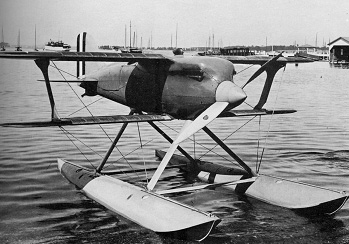
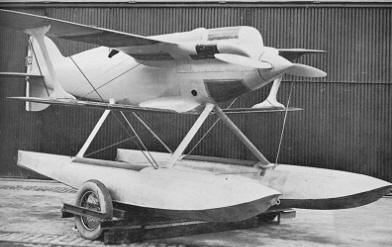
Curtiss CR-3
Gloster III
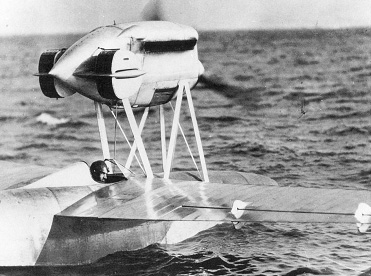
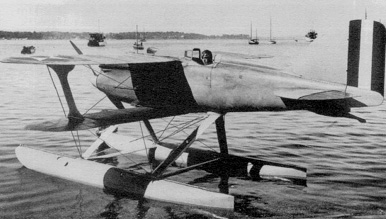
Macchi M. 33
Curtiss R3C-2
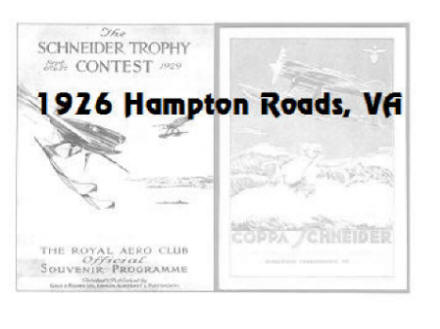
November 12-13, 1926 Hampton Roads, VA
7 Laps of a 50 km. course
|
No |
Pilot | Aircraft | Country |
Speed |
|
5 |
Mario de Bernardi |
Macchi M.39 |
Italy |
246.4 |
|
6 |
Christian Schillt |
Curtiss R3C-2 |
USA |
231.3 |
|
1 |
Adriano Bacula |
Macchi M.39 |
Italy |
218.0 |
|
2 |
William Tomlinson |
Curtiss F6C-3 |
USA |
136.9 |
|
4 |
George Cuddihy |
Curtiss R3C-4 |
USA |
* |
* out lap 7 Ran out of fuel.
With two wins in a row the US felt pretty confident about their Curtis's securing the trophy.
The Curtiss R3C-3 received a 700 hp Packard engine and Curtiss V-1500 was installed in
the R3C-4. Britain's Supermarine and Gloster Aircraft Companies were still in the design
stage with their next racers and were not able to send a competitor. The chief designer
for the Italian Macchi racers was at the 1925 races and took photos of Doolittle's racer to
study it's design. With what he observed from the Curtiss racer and the cantilever design of
Supermarine wing he designed the Macchi M.39. The race was a match between the US
and the Italians. The new Macchi was fast but very difficult to fly and experienced engine
overheating. George Cuddihy and his Curtiss was not able to catch Mario de Bernardi's racer.
The pump that transferred reserve fuel from the floats to the main tank of Cuddihy Curtiss
failed causing the engine to quit. He landed only several hundred feet from the finish line.
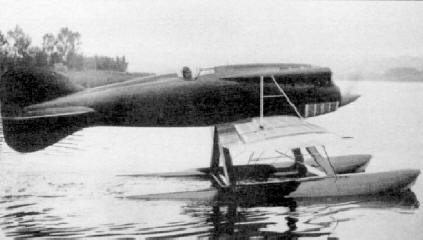
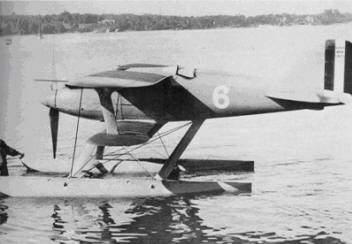
Macchi M. 39
Curtiss R3C-2
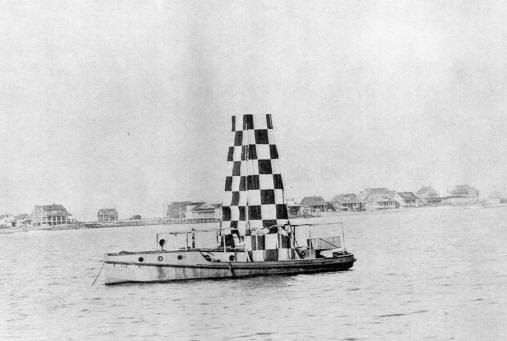
Boat Pylon
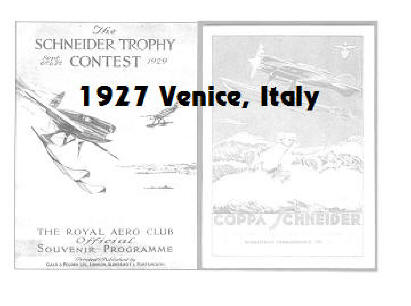
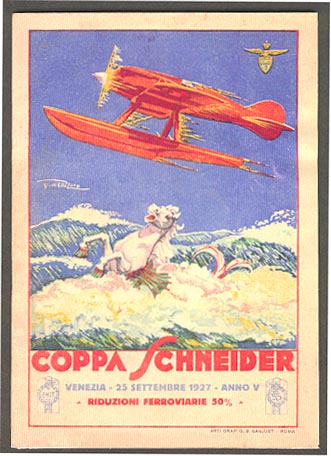
1927 Poster
Italy, produced four new monoplane Macchi M.52 racers with improved engines.
The M.52's proved difficult to fly and were plagued with engine cooling
problems.
A private US company was developing a plane with a 24 cylinder 1,250 hp
engine
for Navy Lieutenant Al Williams to fly but was unable to complete the racer in
time.
Britain entered three Gloster biplanes
and two Supermarine monoplanes all with
the same engine. The Italian crowd of 200,000 spectators were
disappointed to
see all four Macchi 52's out due to engine failure. The
two Supermarine's finished
the race with Sidney Webster's No 4 winning at close to 300 mph. The
Schneider
Trophy racers with their streamlined floats were now flying faster than land
planes.
September 26, 1927 Venice, Italy
7 laps of a 50km. course
|
No |
Pilot | Aircraft | Country |
Speed |
|
4 |
Sidney Webster |
Supermarine S.5 |
Great Britain |
281.6 |
|
6 |
Oswald Worsley |
Supermarine S.5 |
Great Britain |
272.9 |
|
5 |
Frederico Guazetti |
Macchi M.52 |
Italy |
* |
|
1 |
S.M. Kinkead |
Gloster IVB |
Great Britain |
** |
|
2 |
Mario de Bernardi |
Macchi M.52 |
Italy |
*** |
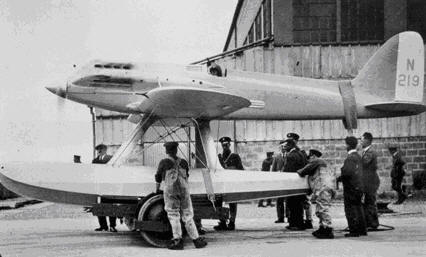
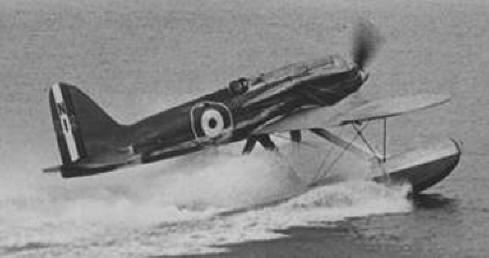
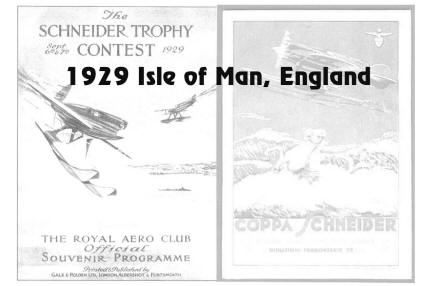
September 6-7, 1929 Isle of Man, England
7 laps of a 50km. course
Jacques Schneider died in
1928 and the event was cancelled for the year.
France built three aircraft for this years race but soon realized
they were
not going to be contenders. Germany displayed an interest but their racer
never went beyond the drawing board. The Italian
government made a
major effort to regain the trophy with several new innovative designs. One
design called for the floats to be replaced with hydrofoils. This unusual
craft
was not popular with pilots, several were refusing to fly it. Another design
mounted two 1,000 hp engines mounted in tandem back to back with
very long floats to support the single tail. These two extreme examples
did not appear as starters. The Macchi M.39 was upgraded to a M.67
using a advanced 1,800 hp Asso V-18 engine driving a three bladed prop.
This hot new engine had not undergone sufficient testing and the Italian
public expressed their concern when several engines either exploded or
seized during test runs. However three M.67's were built with 27 engines
available to use. During a early test run the pilot of a M.67 reached a speed
of 362 mph but a short time later the racer went into a dive and crashed
killing the pilot. The Italian government asked the Royal Aero Club to
postpone the race till next year but was refused. The first M.67's engine
caught fire on the first pylon turn and the second one completed one lap and
had to land.
|
No |
Pilot | Aircraft | Country |
Speed |
|
2 |
Henry Waghorn |
Supermarine S.6A |
Great Britain |
328.6 |
|
4 |
Tomaso Dal Molin |
Macchi M.52R |
Italy |
284.2 |
|
5 |
D'Arcy Greig |
Supermarine S.5 |
Great Britain |
282.1 |
|
8 |
Richard Atcherly |
Supermarine S.6A |
Great Britain |
* |
|
7 |
Remo Cadringher |
Macchi M.67 |
Italy |
** |
|
10 |
Giovanni Monti |
Macchi M. |
Italy |
*** |
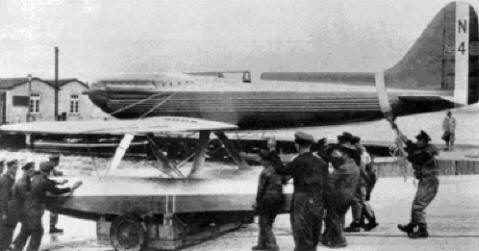
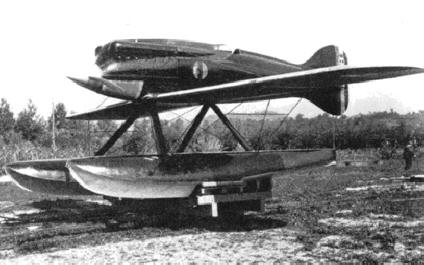
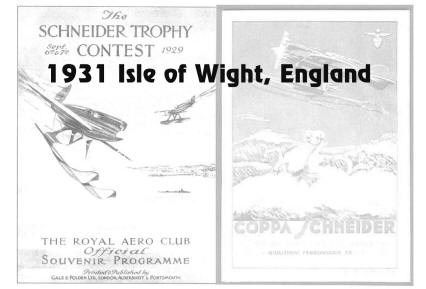
September 13, 1931 - Isle of Wight, England
7 laps of a 50km. course
Sometime in the early part of 1931 the British
Parliament decided not to enter
a RAF team in the Schneider Race leaving the private sector to organize
and
run the event. Lady Lucy Huston, perhaps the richest woman in Europe was
contacted for financial help. Lady Huston agreed to donate
£100,00 to enable
Britain to enter the contest. The Prime Minister was quick to allow the RAF to
defend the Schneider Trophy. Supermarine and Rolls-Royce agreed to start
work to upgrade
existing aircraft and engines and Rolls-Royce managed to
increase
power on the
R engine to 2,300hp. Two new aircraft were built, a
S6B and two S6's were
upgraded.
Italy developed the MC. 72 two were sent
sending it to their training base, however they were
plagued with carburetor
problems.
During a training flight a MC.72 experienced a engine back fire and
crashed killing the pilot.
Only two days before a second MC. 72 on a high
speed run crashed into high
ground.
The two crashes and other problems
caused Italy to withdraw. France and Germany both
had plans but were
unable to complete any aircraft. With the British
unopposed, the race became
a 'fly-over'.
RAF pilot John Boothman would complete the race at the
average
speed of 340.08 mph winning the Schneider
Trophy for Great Britain. On 29
September George Stainforth in a S.6B set a
world speed record of 407.5mph.
|
No |
Pilot | Aircraft | Country |
Speed |
|
1 |
John Boothman |
Supermarine S.6B |
Great Britain |
340. |
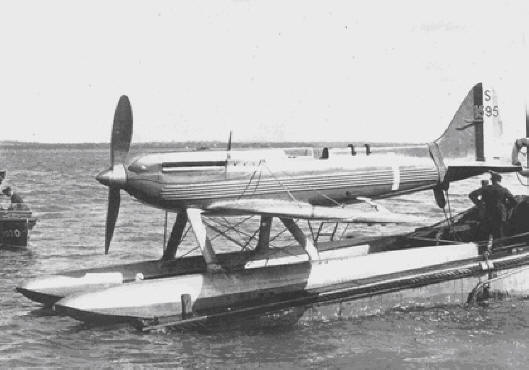
You are the
th person to visit this page since 05-13-12